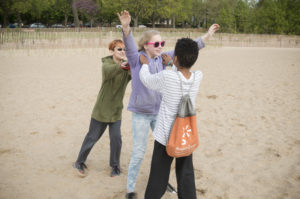Fostering Connections to Freshwater Ecosystems

To view the photo-rich magazine version, click here.
Originally appears in the Fall 2017 issue
by Gabby Petrelli and Katie Larson
Those of us lucky enough to live in the Great Lakes region have been gifted a vital, natural resource that provides us with incredible opportunities. The Great Lakes provide drinking water to 40 million people and jobs to thousands. They’re home not only to us, but to over 3,500 other species. While the Great Lakes are unique in their size and beauty, students can also make personal connections while exploring the freshwater ecosystems in their own communities. Have your students visited lakes, rivers, streams, ponds or other sources of freshwater in your region?
When we have the chance to bring students out to a local beach, river, wetland, or other ecosystem, students describe their experiences in these natural areas as relaxing, peaceful, beautiful and happy. By continuing to encourage this appreciation for the lakes and other freshwater ecosystems, we can help foster an ongoing ethic of care and responsible decision making surrounding these resources.
With this in mind, our organization created the Great Lakes in My World curriculum kits. As with all place-based education programs, this curriculum encourages teachers and students to go out into their communities. When educators take students out to the water or begin teaching about watersheds, we hope that students think about their personal connection to the local waterways and ask questions such as the following: Where is the nearest lake or river in relation to my home and school? Is it part of my community? What can I do there? How does being outside make me feel? These types of questions are important as many students may not have thought about the importance of having clean freshwater, and some may have never even visited their local waterways at all.
As you spend time with your students exploring the landscape, encourage them to ask questions such as: What kinds of plants and animals live here? How do they survive? How do they interact with or depend on other organisms? How do they interact with abiotic factors in their environment? Students can begin to think about food chains, and how the introduction or extinction of a single species can affect the entire food web. Or, they can explore topics related to watersheds: What is a watershed? What types of waterways in a watershed connect to the land around my home? How does pollution on the roads or in the stream near my house affect the lake it runs into? Students may even begin to think about how they fit into the ecosystem and the effects their actions have on the watershed.
This content is restricted to subscribers only.
If you are not yet a subscriber, please consider taking out a subscription here.
If you are an existing subscriber, kindly log in or contact us at info@greenteacher.com for more information.





